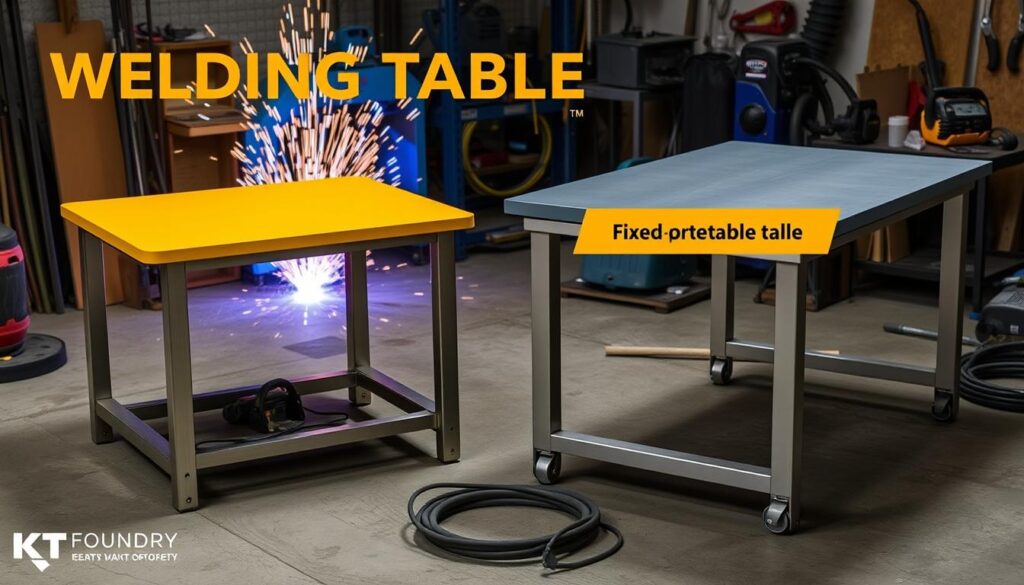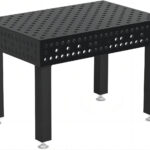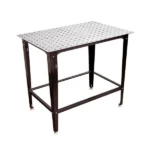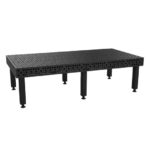Choosing the right welding equipment is key to the quality of your work and how efficiently you work. A welding table is a crucial tool for welders. It's a strong and flexible surface that helps you work better. You'll need to decide between a fixed or portable welding table. The choice depends on your workspace, what you're working on, and what you prefer.
Key Takeaways
- Welding tables provide a stable, heat-resistant platform for welding tasks, allowing welders to work comfortably and safely.
- The choice between a fixed or portable welding table depends on factors such as workspace, project needs, and budget.
- Portable welding tables offer increased mobility and flexibility, making them a versatile option for both DIY enthusiasts and professional welders.
- Key considerations when selecting a welding table include size, material, weight capacity, stability, and portability features.
- Investing in the right welding table can enhance productivity, work quality, and overall efficiency in your welding projects.
Understanding Welding Tables
Welding tables are key in any welding workshop. They are waist-level platforms made of strong steel. Welding tables are designed to be heat-resistant and safe for welding and metal work. They help with tasks like squaring corners and holding tools.
What is a Welding Table?
A welding table is crucial for welding or metalworking. They come in sizes from 20" x 40" to 6.5' x 13', fitting any workshop size. Many tables have adjustable legs for comfort, whether you're sitting or standing.
Benefits of Using a Welding Table
A welding table offers a stable, heat-safe surface for welding and metal work. It's great for many tasks, such as:
- Squaring corners and aligning pieces
- Gauging and measuring components
- Mounting jigs, tools, and accessories
- Bending and forming metal
- Providing a secure grounding point for electrical work
Using a welding table boosts accuracy, efficiency, and safety in your work. This leads to better results and a more productive workshop.

Welding Tables: Key Factors to Consider
Choosing the right welding table is key to your work's success. You need to think about size, material, and weight capacity. Each factor affects how well your welding tables, fabrication tables, and metal worktables work.
Size and Dimensions
The size of a welding table is crucial. It should fit your projects, with a length and width of at least 4 feet for big workpieces. For smaller tasks, a 2-3 feet table is enough. Some tables also have modular or folding designs for different spaces.
Material and Construction
Welding tables are made from strong materials like steel or cast iron. Steel is great for heavy work, while cast iron is stable and resists heat well. Aluminum is lighter and won't rust, perfect for portable setups.
Weight Capacity
The table's weight capacity is vital. It tells you the heaviest load it can hold without bending or tipping. Make sure it can carry your workpieces, tools, and equipment.
Stability and Leveling Options
A stable welding table is crucial for precise and safe work. Choose tables with adjustable feet or leveling systems. This keeps your work flat and aligned during welding.
Mobility and Portability
If you move your welding table often, look for a portable one. Portable tables are great for welders who work on-site or in small spaces. They offer flexibility and convenience.
Accessories and Add-ons
Many welding tables come with useful accessories. These include clamps, vices, trays, magnets, and angled rails. Some even have hooks for cables and equipment. These features help keep your workspace tidy and efficient.
Conclusion
Choosing the right welding table is key to improving our welding projects. We need to think about size, material, and how much it can hold. We should also consider how stable and easy it is to move, and what accessories it comes with. Whether we choose a fixed or portable table, the right one will help us work better and safer.
Getting the right welding table can really change how well we do our welding. We should look for tables that are strong, easy to adjust, and have useful accessories. This way, our welding table will meet our project needs and help us succeed in welding.
As we keep learning about welding, picking the right welding table is very important. By making smart choices, we can get the most out of our welding table. This leads to better precision, efficiency, and safety in our work.
FAQ
What is a welding table?
A welding table is a waist-level platform for welding and metal fabrication. It's made from steel to prevent fires and provide a stable, heat-resistant surface.
What are the benefits of using a welding table?
Welding tables offer a stable surface for various tasks like squaring corners and measuring. They allow welders to sit or stand comfortably, improving productivity.
What factors should I consider when choosing a welding table?
Consider size, material, weight capacity, stability, mobility, and accessories when picking a welding table.
What are the differences between fixed and portable welding tables?
Fixed tables are stable and permanent, while portable tables are flexible for on-site work or small workshops.
What types of materials are welding tables made from?
Welding tables are made from steel, cast iron, or aluminum. Steel is durable and heat-resistant, while cast iron offers stability. Aluminum is lightweight and corrosion-resistant.
How important is the weight capacity of a welding table?
The weight capacity is crucial to ensure the table supports your workpieces, welding machine, and tools without becoming unstable.
What features should I look for in a stable welding table?
Look for adjustable feet or leveling mechanisms for a stable table. This ensures your workpieces stay aligned during welding.
What types of accessories are available for welding tables?
Welding tables often have clamps, vices, trays, magnets, and angled rails. Some also have hooks for cables and welding guns, keeping the workspace tidy.




